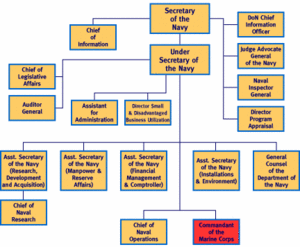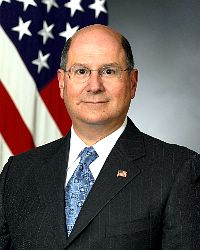Secretary of the Navy (U.S.): Difference between revisions
imported>Howard C. Berkowitz |
imported>Richard Jensen m (Secretary of the Navy (United States) moved to Secretary of the Navy (U.S.): use U.S. form) |
(No difference)
| |
Revision as of 21:01, 31 May 2008
The Secretary of the Navy (SecNav) is the civilian head of the Department of the Navy, under which are various civilian offices, and two military services, the United States Navy and United States Marine Corps. The professional heads of the services, respectively, are the Chief of Naval Operations (CNO), and the Commandant of the Marine Corps (CMC). Even though the CNO and CMC report to SecNav, none of the three currently have control over the operating forces of the U.S. Navy or United States Marine Corps.
The Department of the Navy was created in 1798, with its own secretary. Nine years earlier Congress created the War Department, headed by the Secretary of War. As a result of the National Security Act of 1947, as amended, the Navy department was merged into the "National Military Establishment," which was renamed the Department of Defense in 1949. SecNav then began to report to the Secretary of Defense (SecDef). Both the SecDef and SecNav are appointed by the President and confirmed by the Senate, and serve at the pleasure of the President.
Control over operating forces starts with the President and Secretary of Defense (SecDef), who direct the commanding officers of the [[Unified Combatant Command]s (UCC). The UCCs, which have components from all the military services and have either a geographic (e.g., Pacific, Central) or functional (e.g., Special Operations, Transportation) responsibility. Jointly, the President and SecDef form the National Command Authority.
It is the responsibility of the Secretary, his civilian deputies (who may have uniformed direct reports), and the CNO and CMC to prepare the forces for operational deployment under the UCCs.
The Secretary of the Navy (SECNAV) is responsible for, and has the authority under Title 10 of the United States Code, to conduct all the affairs of the Department of the Navy, including: recruiting, organizing, supplying, equipping, training, mobilizing, and demobilizing. The Secretary also oversees the construction, outfitting, and repair of naval ships, equipment and facilities. SECNAV is responsible for the formulation and implementation of policies and programs that are consistent with the national security policies and objectives established by the President and the Secretary of Defense. The Department of the Navy consists of two uniformed Services: the United States Navy and the United States Marine Corps.
The Secretaries of the Army and Air Force have similar responsibilities to prepare the force. There is no Secretary of the Marine Corps.
Incumbent
Donald C. Winter is the 74th Secretary of the Navy, sworn into office on Jan. 3, 2006. Prior to joining the Department, he was Dr. Winter served as a corporate vice president and president of Northrop Grumman's Mission Systems sector. In that position he oversaw operation of the business and its 18,000 employees, providing information technology systems and services; systems engineering and analysis; systems development and integration; scientific, engineering, and technical services; and enterprise management services. Dr. Winter also served on the company's corporate policy council.
Previously, Dr. Winter served as president and CEO of TRW Systems, a major defense contractor, where he had earlier been vice president and deputy general manager for group development of TRW’s Space & Electronics business; and vice president and general manager of the defense systems division of TRW.
From 1980 to 1982, he was a government official in the Department of Defense, as program manager for space acquisition, tracking, and pointing programs in the Defense Advanced Research Projects Agency (DARPA).
Dr. Winter earned a bachelor’s degree (with highest distinction) in physics from the University of Rochester in 1969. He received a master’s degree and a doctorate in physics from the University of Michigan in 1970 and 1972, respectively. He is a 1979 graduate of the USC Management Policy Institute, a 1987 graduate of the UCLA Executive Program, and a 1991 graduate of the Harvard University Program for Senior Executives in National and International Security. In 2002, he was elected a member of the National Academy of Engineering

